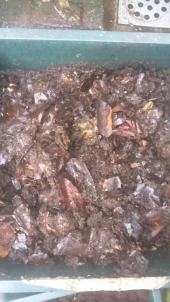
 3
3




“We can complain because rose bushes have thorns, or rejoice because thorn bushes have roses.” — Abraham Lincoln
 2
2




Fish heads fish heads roly poly fish heads
 4
4




 3
3




“We can complain because rose bushes have thorns, or rejoice because thorn bushes have roses.” — Abraham Lincoln

 5
5




List of Bryant RedHawk's Epic Soil Series Threads We love visitors, that's why we live in a secluded cabin deep in the woods. "Buzzard's Roost (Asnikiye Heca) Farm." Promoting permaculture to save our planet.
 4
4




Chris
Gardening in the UK and loving it in spite of the heavy clay, deer, pheasants, slugs....
 1
1




“We can complain because rose bushes have thorns, or rejoice because thorn bushes have roses.” — Abraham Lincoln
 1
1




 1
1




 4
4




"The rule of no realm is mine. But all worthy things that are in peril as the world now stands, these are my care. And for my part, I shall not wholly fail in my task if anything that passes through this night can still grow fairer or bear fruit and flower again in days to come. For I too am a steward. Did you not know?" Gandolf
 1
1




A piece of land is worth as much as the person farming it.
-Le Livre du Colon, 1902
 1
1




“We can complain because rose bushes have thorns, or rejoice because thorn bushes have roses.” — Abraham Lincoln
 2
2




Life on a farm is a school of patience; you can't hurry the crops or make an ox in two days.
Henri Alain
 2
2




“We can complain because rose bushes have thorns, or rejoice because thorn bushes have roses.” — Abraham Lincoln
 1
1




Bryant RedHawk wrote:Worms are good at moving to ideal conditions in the "wild". Problems come from our desire for their product causing us to create artificial living quarters and enviroment. With "worm farms" we must monitor moisture level, temperature and food supply. Records are needed to know how you are doing and success over the long term. Castings quality is mostly from a variety of food offerings instead of a limited diet.
Redhawk
(Bacteria are the real gold of the castings)




“We can complain because rose bushes have thorns, or rejoice because thorn bushes have roses.” — Abraham Lincoln












 1
1




Mary Gallos wrote:
Bryant RedHawk wrote:Worms are good at moving to ideal conditions in the "wild". Problems come from our desire for their product causing us to create artificial living quarters and enviroment. With "worm farms" we must monitor moisture level, temperature and food supply. Records are needed to know how you are doing and success over the long term. Castings quality is mostly from a variety of food offerings instead of a limited diet.
Redhawk
(Bacteria are the real gold of the castings)
I'd love to know whether I'm missing something in the following train of thought.
1. it's the rotting food we want contained, not necessarily the worms
2. worm tunnels (where they come to snack, but can come and go freely) work well, as long as there is a large surface area for feeding).
3. dumping a whole finished worm farm tray onto (shaded) ground would see worms burrow away from light, into the soil, leaving a pile of castings that could be (mostly) scooped up
4. providing fresh bedding and tasty worm food in the (otherwise empty) tray, adjacent to this pile, would tempt (most of) them back into the tray when conditions suited them (e.g. sun had set, and ground temperature had cooled).
This seems a low input way to "harvest" castings, break up the soil, and keep it all going. If it works.
I'd love thoughts on why it might not work, before I risk my worms.
List of Bryant RedHawk's Epic Soil Series Threads We love visitors, that's why we live in a secluded cabin deep in the woods. "Buzzard's Roost (Asnikiye Heca) Farm." Promoting permaculture to save our planet.
 2
2




New location. Zone 6b, acid soil, 30+ inches of water per year.
https://growingmodernlandraces.thinkific.com/?ref=b1de16
Growingmodernlandraces.com affiliate
 2
2




“We can complain because rose bushes have thorns, or rejoice because thorn bushes have roses.” — Abraham Lincoln


.jpg)
